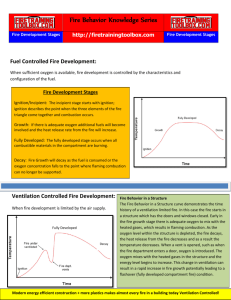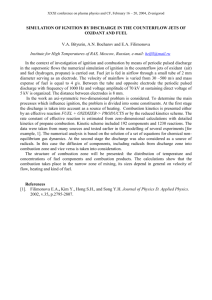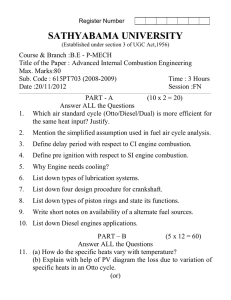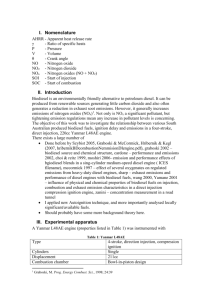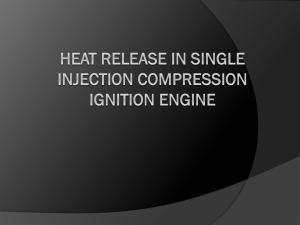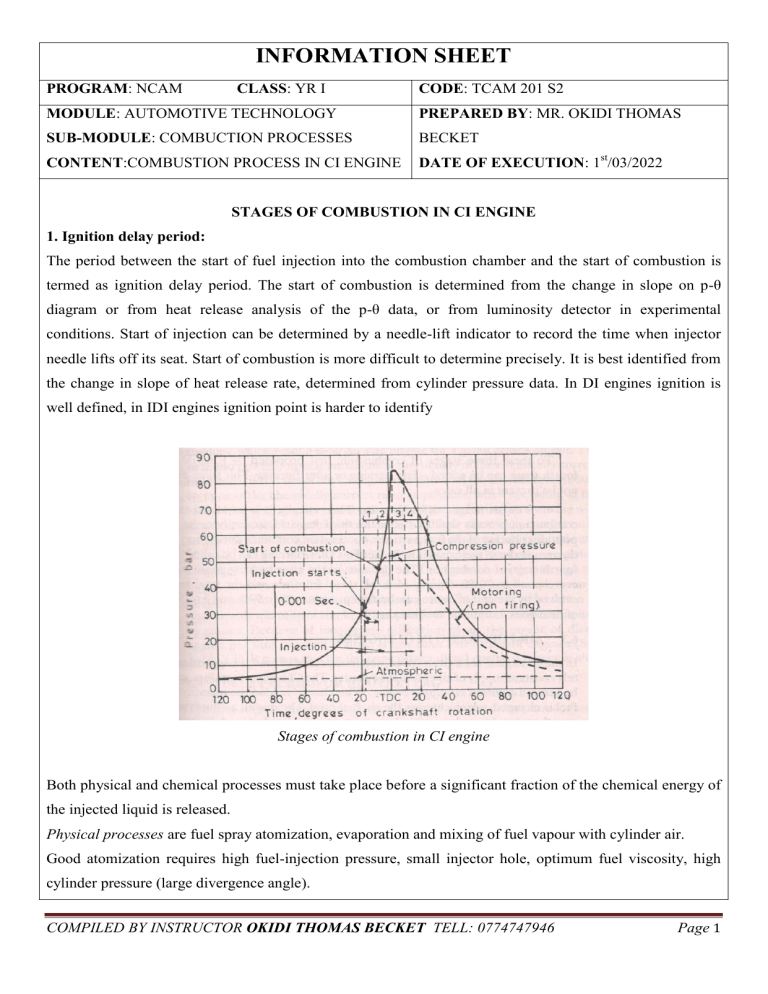
INFORMATION SHEET PROGRAM: NCAM CLASS: YR I CODE: TCAM 201 S2 MODULE: AUTOMOTIVE TECHNOLOGY PREPARED BY: MR. OKIDI THOMAS SUB-MODULE: COMBUCTION PROCESSES BECKET CONTENT:COMBUSTION PROCESS IN CI ENGINE DATE OF EXECUTION: 1st/03/2022 STAGES OF COMBUSTION IN CI ENGINE 1. Ignition delay period: The period between the start of fuel injection into the combustion chamber and the start of combustion is termed as ignition delay period. The start of combustion is determined from the change in slope on p-θ diagram or from heat release analysis of the p-θ data, or from luminosity detector in experimental conditions. Start of injection can be determined by a needle-lift indicator to record the time when injector needle lifts off its seat. Start of combustion is more difficult to determine precisely. It is best identified from the change in slope of heat release rate, determined from cylinder pressure data. In DI engines ignition is well defined, in IDI engines ignition point is harder to identify Stages of combustion in CI engine Both physical and chemical processes must take place before a significant fraction of the chemical energy of the injected liquid is released. Physical processes are fuel spray atomization, evaporation and mixing of fuel vapour with cylinder air. Good atomization requires high fuel-injection pressure, small injector hole, optimum fuel viscosity, high cylinder pressure (large divergence angle). COMPILED BY INSTRUCTOR OKIDI THOMAS BECKET TELL: 0774747946 Page 1 Rate of vaporization of the fuel droplets depends on droplet diameter, velocity, fuel volatility, pressure and temperature of the air. Chemical processes similar to that described for auto ignition phenomenon in premixed fuel-air, only more complex since heterogeneous reactions (reactions occurring on the liquid fuel drop surface) also occur. Chemical delay is more effective for the duration of the ignition delay period. Ignition delay period is in the range of: 0.6 to 3 ms for low-compression ratio DI diesel engines, 0.4 to 1 ms for high-compression ratio, turbocharged DI diesel engines, 0.6 to 1.5 ms for IDI diesel engines 2. Rapid or uncontrolled or pre-mixed combustion phase: Combustion of the fuel which has mixed with air within flammability limits during ignition delay period occurs rapidly in a few crank angle degrees - high heat release characteristics in this phase. If the amount of fuel collected in the combustion chamber during the ignition delay is much - high heat release rate results in a rapid pressure rise which causes the diesel knock. For fuels with low cetane number, with long ignition delay, ignition occurs late in the expansion stroke incomplete combustion, reduced power output, poor fuel conversion efficiency. If the pressure gradient is in the range 0.4 - 0.5 MPa/oCA, engine operation is not smooth and diesels knock starts. This value should be in the range 0.2 to 0.3 MPa/oCA for smooth operation (max allowable value is 1.0 MPa/oCA) of the engine. 3. Controlled or diffusion combustion phase: Once the fuel and air which is pre-mixed during the ignition delay is consumed, the burning rate (heat release rate) is controlled by the rate at which mixture becomes available for burning. The rate of burning in this phase is mainly controlled by the mixing process of fuel vapour and air. Liquid fuel atomization, vaporization, pre flame chemical reactions also affect the rate of heat release. Heat release rate sometimes reaches a second peak (which is lower in magnitude) and then decreases as the phase progresses. Generally it is desirable to have the combustion process near the TDC for low particulate (soot) emissions and high performance (and efficiency). 4. After burning or late combustion phase: Heat release rate continues at a lower rate into the expansion stroke -there are several reasons for this: a small fraction of the fuel may not yet burn, a fraction of the energy is present in soot and fuel-rich combustion products and can be released. The cylinder charge is non-uniform and mixing during this phase promotes more complete combustion and less dissociated product gases. Kinetics is slower. COMPILED BY INSTRUCTOR OKIDI THOMAS BECKET TELL: 0774747946 Page 2 VARIABLES AFFECTING DELAY PERIOD (i) Cetane number Both physical and chemical properties of the fuel are important. Ignition quality of the fuel is defined by its cetane number. Straight chain parafinic compounds (normal alkanes) have highest ignition quality, which improves as the chain length increases. Aromatic compounds, alcohols have poor ignition quality. Cetane number can be increased by ignition-accelerating additives like organic peroxides, nitrates, nitrites and various sulphur compounds. Most important (commercially) is alkyl nitrates – about 0.5% by vol in a distillate fuel increase CN by 10. Normal diesel fuel has CN of 40 to 55 (high speed 50 – 60, low speed 25 – 45 (ii) Injection timing At normal operating conditions min ignition delay (ID) occurs with start of injection at 10 to 15 OCA BTDC Cylinder temperature and pressure drops if injection is earlier or later (high at first but decrease as delay proceeds) (iii) Injection quantity (load) Reducing engine load changes AFR, cools down the engine, reduces wall temperatures, reduces residual gas temperatures and increase ID Droplet size, injection velocity and rate Ignition quality within practical limits do not have significant effect on ID Increase in injection pressure produces only modest decrease in ID Injector nozzle diameter -effects of droplet size but has no significant effect on ID (iv) Intake air temperature and pressure Reducing intake air T and p increase ID Strong dependence of ID on charge temperature below 1000 K – above this value effect of intake air conditions is not significant. (v) Engine speed Increase in engine speed increases the air motion and turbulence, reduces ID time slightly (in ms), in terms of CA degrees ID increases almost linearly. A change in engine speed, changes “temp~time” and “pressure~time” relationships COMPILED BY INSTRUCTOR OKIDI THOMAS BECKET TELL: 0774747946 Page 3 (vi) Combustion chamber design Spray impingement on the walls effect fuel evaporation and ID increase in compression ratio, increase p and T and reduces ID Reducing stroke volume, increase surface area to volume ratio, increase engine cooling and increase ID (vii) Swirl rate Change of evaporation rate and air-fuel mixing - under normal operating conditions the effect is small. At start-up (low engine speed and temperature) more important, high rate of evaporation and mixing is obtained by swirl (viii) Oxygen concentration Residual gases reduce O2 concentration and reducing oxygen concentration increases ID DIESEL KNOCK CI engine detonation occurs in the beginning of combustion. In CI engine the fuel and air are imperfectly mixed and hence the rate of pressure rise is normally cause audible knock. Rate of pressure rise may reach as high as 10 bar/ᵒCA High engine vibration is the symptoms of knocking No pre-ignition or premature ignition as like SI engine Detonation in SI and CI engine COMPILED BY INSTRUCTOR OKIDI THOMAS BECKET TELL: 0774747946 Page 4 COMBUSTION CHAMBER According to the swirl of air (a) Induction swirl or open chamber or non-turbulent chamber (b) Compression swirl (c) Combustion induced swirl According to speed of the engine (a) Low speed engine (n˂1500 rpm): - Shallow, swirl-less combustion chambers -Direct, multi-jet fuel injection (b) Medium speed engine (n=1500-3000 rpm): -Deep combustion chambers with intensive swirl of charge -Direct injection of atomised fuel (c) high speed engine (n=3000-5000 rpm): -Pre-chambers (sectional combustion chambers) -Indirect injection of fuel into the pre-chamber COMPILED BY INSTRUCTOR OKIDI THOMAS BECKET TELL: 0774747946 Page 5
